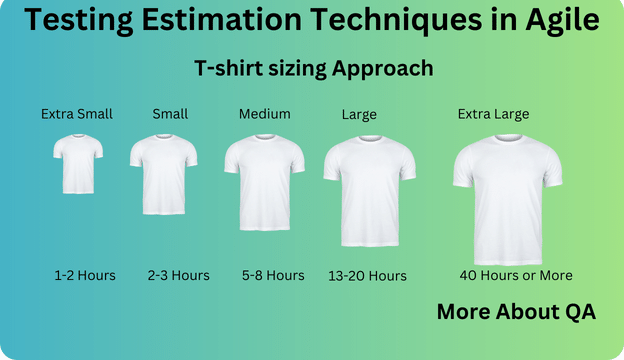
Introduction
Testing estimation techniques in agile are not so different from traditional estimation. In most cases, techniques remain the same, it’s just labels that get changed. However, in this blog, we will discuss various techniques that are used in the field of software development. Accurate testing estimation is vital to plan sprints, allocate resources effectively, and meet project deadlines. Here, we will talk about estimation techniques along with various testing estimation techniques that are only used in agile, their importance, common challenges, and best practices to improve accuracy.
Testing Techniques
Test estimation is the predicted time of a test-related work to meet the objectives of testing. For example, there is a login page, and test-related work against this page includes, requirements analysis, test case design, test case implementation, test case execution, etc. so the predicted time to execute all these activities related to the login page is called estimation.
It is most common that a larger item is hard to estimate, that’s why the better solution is to break it down into small tasks and estimate the small task, that estimation will be more accurate than the one which is made against the big task.
Estimation based on Ratios.
This technique relies on looking at how things went in past projects to make guesses about how things will go in new projects. This technique is somewhat relatable to the experienced-based estimation technique. It’s like saying, “Last time, the testing part took 40% of the time, so maybe it will be similar this time.”
Easy to estimate testing activities but if your project is not of the same nature as previous projects were or your development estimations are not as accurate as they were in the past your testing estimate might be off too.
Extrapolation
In this technique, early project measurements are collected, and data is extrapolated using mathematical models to approximate the effort required for the remaining work. It’s particularly useful in iterative software development life cycles.
A simple example could be if you have completed half of your testing work in a day, they judge the remaining work to be completed on another day. Estimating future progress is based on what you’ve done so far.
Wideband Delphi
This is an expert-based technique, experts estimate efforts based on experience. Each expert, in isolation, estimates the effort. As in the method, experts make their guesses about something. If their guesses are very different from what they all agreed upon earlier, they talk about it. Then, each expert makes a new guess based on what they talked about, but they do it alone. They keep doing this until they all agree on a guess.
Three-Point Estimation, My Favorite.
In this technique, experts provide three estimates: optimistic (a), likely (m), and pessimistic (b). The final estimate (E) is calculated as a weighted arithmetic mean, typically using E = (a + 4m + b) / 6. This method also allows experts to calculate the measurement error (SD) as SD = (b – a) / 6, providing a range of estimation values.
why it’s so Essential in the Agile?
We need to dive into the techniques for testing estimation in Agile, let’s try to understand what Agile is and why it’s so essential in the Agile development process.
Agile which is a project management and development approach is the most used software development industry. hat prioritizes individuals and interactions, working solutions, customer collaboration, and responding to change over rigid processes and documentation. Agile has various frameworks, Scrum is a specific Agile framework that focuses on iterative development and teamwork. Testing estimation is an important aspect of Agile that often poses challenges.
Agile methodologies emphasize delivering workable software in short iterations, known as sprints. Accurate testing estimation is a key factor in ensuring that testing activities align with the sprint’s goals and timelines. Here are some key reasons why testing estimation is so Important in Agile
Resource Allocation
Testing estimation helps in resource allocation, the management allocates the right number of resources to testing activities, which confirms that they don’t overwhelm or underutilize their testing team.
Sprint Planning
Accurate estimation helps sprint planning, building confidence to commit to a realistic amount of work that can be completed within the sprint.
Predictability
It enhances predictability, as stakeholders can rely on the estimated timelines for testing completion.
Risk Management
Testing estimation helps to identify potential risks as early in the project, allowing the development team to address issues before they become critical.
Now that the concepts are clear about the importance of testing estimation, let’s discuss the techniques commonly used in Agile projects.
Testing Estimation Techniques in Agile
Different techniques are used to estimate testing efforts in Agile. Each technique has its strengths and weaknesses, and the selection often depends on the project’s specific needs. Here are some of the most common testing estimation techniques:
Expert Judgment
One can refer to it as Wideband Delphi relies on the collective expertise and experience of the testing team. Team members discuss the requirements and tasks and provide their input on how long testing will take based on their expertise.
Historical Data Analysis
In this technique, the team reviews past projects to gather data on testing efforts. The approach we discussed earlier in the blog with the title, “Estimation based on Ratios” This data can be used to estimate future testing efforts, assuming that the new project’s characteristics are like previous ones.
Planning Poker
Planning poker is a collaborative estimation technique where team members assign relative sizes or story points to testing tasks. It encourages discussions and helps the team reach a consensus on the estimates.
Test Point Analysis
Test point analysis involves breaking down testing tasks into individual test points or test cases. Each test point is assigned an estimated effort, and the total effort is calculated by summing all the test points.
T-Shirt Sizing
T-shirt sizing is a simple estimation technique where testing tasks are categorized as small, medium, large, or extra-large based on their complexity and the effort required. It provides a quick way to estimate testing efforts without getting into detailed analysis.
These techniques can be used individually or in combination, depending on the project’s nature and the available information.
Factors Affecting Testing Estimation
Several factors can influence the accuracy of testing estimation in Agile projects. It’s important to consider these factors when using estimation techniques:
Scope and Complexity of the Project
The size and complexity of the project play a significant role in testing estimation. Larger and more complex projects typically require more testing effort.
Team Experience and Skills
The experience and skills of the testing team can impact estimation accuracy. A highly skilled and experienced team may complete tasks more efficiently than a less experienced one.
Tools and Infrastructure
The availability of testing tools and infrastructure can affect estimation. Well-equipped teams can often complete tasks faster than those with limited resources.
Changes in Requirements
Agile projects are known for their flexibility, but frequent changes in requirements can make estimation challenging. New features or modifications can impact testing timelines.
Best Practices for Testing Estimation in Agile
To improve the accuracy of testing estimation in Agile, consider these best practices:
- Involve the entire team in estimation discussions to leverage diverse perspectives.
- Use historical data but ensure it’s relevant to the current project’s context.
- Continuously refine and update estimates as the project progresses, and more information becomes available.
Keep in mind that estimates are predicted time, not guarantees, and communicate this to stakeholders. Regularly review and adapt your estimation techniques to account for changing project dynamics.
Conclusion | Testing Estimation Techniques in Agile
Testing estimation is an important aspect of software development that contributes to project success. Similarly if you are working using Agile model then, testing estimation techniques in Agile needs to be clear to you. As by understanding the importance of testing estimation, utilizing common estimation techniques, considering associated factors, following best practices, and being aware of potential risks, Agile teams can enhance their ability to plan, deliver, and test software effectively. Accurate testing estimation ultimately leads to higher product quality and customer satisfaction.
